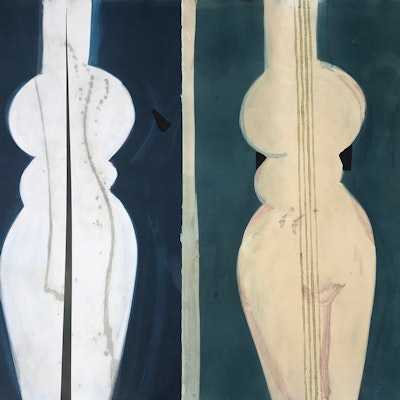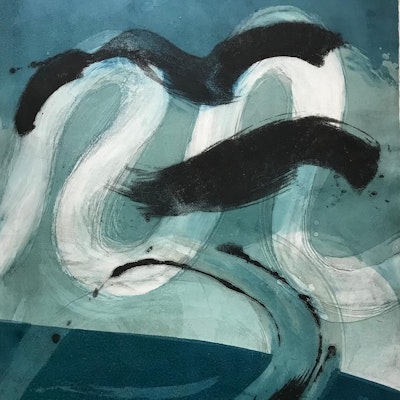Susan Moxley
Susan MOXLEY
Text by Jenny Blyth
Enquiries : jennyblythart@gmail.com
Susan Moxley grew up in South Africa where she graduated with distinction from Durban School of Art travelling to London for a Post Graduate Degree in Printmaking. On her return to South Africa she worked for an NGO, but soon returned again, determined to make a life as an artist in Europe.
Working in a variety of media, Susan creates exquisite collaged textiles, ceramic sculpture and monographs, hand coloured and collaged with chine colle. Although her work is based in figuration, it is largely abstracted. Social politics and narratives remain important to her.
FRESH ART FAIR Cheltenham 2025 showcases her new work - textiles, ceramics and monographs (hand coloured, collaged with chine colle) - reflecting the changing traditions of community on an island in Greece that remains beautiful and captivating in a fast-changing world.
Textiles
‘My stitched paintings have a fragility. I use the same methods of stitch and repair that I find on the cloth, with all the faults and imperfections that contribute to the island’s stories, inspiring me to draw their narratives into the present. I impose my own stories whilst always being aware and respectful of the island women who made them. Each piece is a palimpsest - altered, superimposed, re-contextualised while still bearing traces of its former use’.
Susan Moxley 2025
Splitting their time between UK and Greece, Susan and husband Korky Paul, have maintained a home as artists on an Ionian island for more than four decades. Over the years, she has collected old, hand spun yarns and handwoven functional fabrics. Their patinas, stains and darned patches speak of the island’s past austerity when resources were precious and everything was reused and recycled. Traditional weaving methods have long been lost with the post-war migration, commercial development and availability of modern industrially-made textiles. The discarded fabrics that she selects for her ‘textile paintings’ were woven by women on heavy wooden looms from goat and sheep’s wool, flax, cotton and linen that were grown, spun on the island and dyed with natural pigments.
While raising her children Susan spent many evenings with older women, learning their crafts and listening to their stories of village life, hardships, song and myth. She stitched these stories into the found fabrics while superimposing her own observations, feelings and artistic experiences, using the found fabrics as her canvas and palate, their repairs, tares and textures as inspiration and her stitched thread as the drawn line.
First Storm is a 2m collaged landscape that follows a gathering storm. The work acknowledges the impact of climate change on the island where water is scarce. Susan’s stitching captures the movement of the wind increasing in intensity as it spins and dances a path between the houses, across the sky. The geometry that she creates in her kaleidoscope of chosen fabrics speaks of the distinctive architecture, coloured by the earth’s pigments and flora. The tones echo the sun-bleached whites of the buildings, rust-red earth, and the azure blue of sea and sky.
During her search for hand woven fabrics, Susan found a discarded violin case. She has lined the case in woollen fabric, the female form, stitched in red thread creates a playful fusion of music and beauty. Her Violin Women are a conduit between the textiles and the ceramics.
The connection between Woman and Pithari (vessel) is a recurring theme across Susan’s artistic practice - woman as container, container as woman.
Susan’s Pitharia in stoneware and terracotta celebrate the simplicity and aesthetic of the ancient Cycladic female forms with their flat planes and geometric shapes that so inspired Picasso. There is an honesty and poise to Susan’s ceramic slab -built, bisque fired and waxed nudes, pared back to the abstract. The beautiful Pithari with Minoan Bird above, strung with ivory-coloured horse hair of the violin bow from clavicle to pubic bone, is one in a series of Woman as Vessel, while others hint at the weight of women’s daily labours - balancing firewood, bowls, spindles, loom weights, bolts of fabric , and birds.















